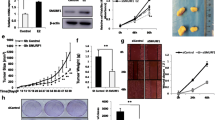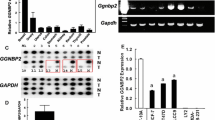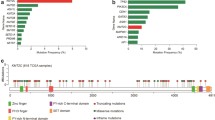Abstract
Breast tumorigenesis and breast cancer progression involves the deregulation or hyperactivation of intracellular signaling proteins that leads to uncontrolled cellular proliferation, invasion and metastasis. For example, the expression and cellular responses to estogen receptor (ER) and transforming growth factor β (TGFβ) signaling pathways change during breast tumorigenesis and breast cancer progression. While the expression and activity of ER and TGFβ maybe significant in the development of breast cancer, alterations in the cross-talk between these pathways may be equally important. Autocrine and paracrine effects of TGFβ on breast cancer cell growth have been known for some time, but only recently have direct interactions between ER and TGFβ been described. The purpose of this article was to further characterize the cross-talk between ER and TGFβ, by examining ER interaction with Smad3, a downstream mediator of TGFβ signaling. Transient transfection of Cos1 cells with p3TP-lux, demonstrate that ERα and ERβ1 repress Smad3 transcriptional activity in an estradiol-dependent manner and that this effect is inhibited by antiestrogen treatment. The ERβ variants, ERβ2 and ERβ5, did not have any effect on Smad3 transcriptional activity. Further experiments attempted to characterize the molecular mechanism by which activated ER inhibits Smad3 transcriptional activity. Results indicate that ligand-bound ER does not affect Smad3 protein expression levels and that ER does not form direct protein interactions with Smad3. Transient transfection of Cos1 cells with the Ap-1 transcription factor c-Jun but not c-Fos was able to rescue the inhibitory effect of estrogen on Smad3 transcriptional activity. Based on these results, a model is proposed whereby c-Jun is limiting in its ability to act as a Smad3 co-activator in the presence of E2-bound ER, possibly due to ER sequestering c-Jun away from the Smad3 responsive promoter.







Similar content being viewed by others
References
Murphy LC, Watson P (2002) Steroid receptors in human breast tumorigenesis and breast cancer progression. Biomed Pharmacother 56:65–77
Woodward TL, Xie JW, Haslam SZ (1998) The role of mammary stroma in modulating the proliferative response to ovarian hormones in the normal mammary gland. J Mammary Gland Biol Neoplasia 3:117–131
Clarke RB, Howell A, Potten CS, Anderson E (1997) Dissociation between steroid receptor expression and cell proliferation in the human breast. Cancer Res 57:4987–4991
Murphy LC, Leygue E, Niu Y, Snell L, Ho SM, Watson PH (2002) Relationship of coregulator and oestrogen receptor isoform expression to de novo tamoxifen resistance in human breast cancer. Br J Cancer 87:1411–1416
Murphy LC, Simon SL, Parkes A, Leygue E, Dotzlaw H, Snell L, Troup S, Adeyinka A, Watson PH (2000) Altered expression of estrogen receptor coregulators during human breast tumorigenesis. Cancer Res 60:6266–6271
Reiss M, Barcellos-Hoff MH (1997) Transforming growth factor-beta in breast cancer: a working hypothesis. Breast Cancer Res Treat 45:81–95
Tong GM, Rajah TT, Zang XP, Pento JT (2002) The effect of antiestrogens on TGF-beta-mediated chemotaxis of human breast cancer cells. Anticancer Res 22:103–106
Koli KM, Arteaga CL (1996) Complex role of tumor cell transforming growth factor (TGF)-beta s on breast carcinoma progression. J Mammary Gland Biol Neoplasia 1:373–380
Xie W, Mertens JC, Reiss DJ, Rimm DL, Camp RL, Haffty BG, Reiss M (2002) Alterations of Smad signaling in human breast carcinoma are associated with poor outcome: a tissue microarray study. Cancer Res 62:497–505
Gorsch SM, Memoli VA, Stukel TA, Gold LI, Arrick BA (1992) Immunohistochemical staining for transforming growth factor beta 1 associates with disease progression in human breast cancer. Cancer Res 52:6949–6952
Walker RA, Dearing SJ (1992) Transforming growth factor beta 1 in ductal carcinoma in situ and invasive carcinomas of the breast. Eur J Cancer 28:641–644
Zugmaier G, Lippman ME (1990) Effects of TGF beta on normal and malignant mammary epithelium. Ann N Y Acad Sci 593:272–275
Benson JR, Baum M, Colletta AA (1996) Role of TGF beta in the anti-estrogen response/resistance of human breast cancer. J Mammary Gland Biol Neoplasia 1:381–389
Chen H, Tritton TR, Kenny N, Absher M, Chiu JF (1996) Tamoxifen induces TGF-beta 1 activity and apoptosis of human MCF-7 breast cancer cells in vitro. J Cell Biochem 61:9–17
Thompson AM, Kerr DJ, Steel CM (1991) Transforming growth factor beta 1 is implicated in the failure of tamoxifen therapy in human breast cancer. Br J Cancer 63:609–614
Matsuda T, Yamamoto T, Muraguchi A, Saatcioglu F (2001) Cross-talk between transforming growth factor-beta and estrogen receptor signaling through Smad3. J Biol Chem 276:42908–42914
Yamamoto T, Saatcioglu F, Matsuda T (2002) Cross-talk between bone morphogenic proteins and estrogen receptor signaling. Endocrinology 143:2635–2642
Yanagi Y, Suzawa M, Kawabata M, Miyazono K, Yanagisawa J, Kato S (1999) Positive and negative modulation of vitamin D receptor function by transforming growth factor-beta signaling through smad proteins. J Biol Chem 274:12971–12974
Yanagisawa J, Yanagi Y, Masuhiro Y, Suzawa M, Watanabe M, Kashiwagi K, Toriyabe T, Kawabata M, Miyazono K, Kato S (1999) Convergence of transforming growth factor-beta and vitamin D signaling pathways on SMAD transcriptional coactivators. Science 283:1317–1321
Song CZ, Tian X, Gelehrter TD (1999) Glucocorticoid receptor inhibits transforming growth factor-beta signaling by directly targeting the transcriptional activation function of Smad3. Proc Natl Acad Sci U S A 96:11776–11781
Hayes SA, Zarnegar M, Sharma M, Yang F, Peehl DM, ten Dijke P, Sun Z (2001) SMAD3 represses androgen receptor-mediated transcription. Cancer Res 61:2112–2118
Kang HY, Lin HK, Hu YC, Yeh S, Huang KE, Chang C (2001) From transforming growth factor-beta signaling to androgen action: identification of Smad3 as an androgen receptor coregulator in prostate cancer cells. Proc Natl Acad Sci U S A 98:3018–3023
Zheng L, Annab L, Afshari C, Lee W, Boyer T (2001) BRCA1 mediates ligand-independent transcriptional repression of the estrogen receptor. Proc Natl Acad Sci U S A 98:9587–9592
Peng B, Lu B, Leygue E, Murphy L (2003) Putative functional characteristics of human estrogen receptor-beta isoforms. J Mol Endocrinol 30:13–29
Peng B, Lu B, Leygue E, Murphy LC (2003) Putative functional characteristics of human estrogen receptor-beta isoforms. J Mol Endocrinol 30:13–29
Jordan M, Wurm F (2004) Transfection of adherent and suspended cells by calcium phosphate. Methods 33:136–143
Chipuk JE, Cornelius SC, Pultz NJ, Jorgensen JS, Bonham MJ, Kim SJ, Danielpour D (2002) The androgen receptor represses transforming growth factor-beta signaling through interaction with Smad3. J Biol Chem 277:1240–1248
Cowley S, Hoare S, Mosselman S, Parker M (1997) Estrogen receptors alpha and beta form heterodimers on DNA. J Biol Chem 272:19858–19862
Verrecchia F, Vindevoghel L, Lechleider RJ, Uitto J, Roberts AB, Mauviel A (2001) Smad3/AP-1 interactions control transcriptional responses to TGF-beta in a promoter-specific manner. Oncogene 20:3332–3340
Liberati NT, Datto MB, Frederick JP, Shen X, Wong C, Rougier-Chapman EM, Wang XF (1999). Smads bind directly to the Jun family of AP-1 transcription factors. Proc Natl Acad Sci U S A 96:4844–4849
Teyssier C, Belguise K, Galtier F, Chalbos D (2001) Characterization of the physical interaction between estrogen receptor alpha and JUN proteins. J Biol Chem 276:36361–36369
Jakacka M, Ito M, Weiss J, Chien PY, Gehm BD, Jameson JL (2001) Estrogen receptor binding to DNA is not required for its activity through the nonclassical AP1 pathway. J Biol Chem 276:13615–13621
Webb P, Lopez GN, Uht RM, Kushner PJ (1995) Tamoxifen activation of the estrogen receptor/AP-1 pathway: potential origin for the cell-specific estrogen-like effects of antiestrogens. Mol Endocrinol 9:443–456
Ogawa S, Inoue S, Watanabe T, Orimo A, Hosoi T, Ouchi Y, Muramatsu M (1998) Molecular cloning and characterization of human estrogen receptor bcx: potential inhibitor of estrogen action in human. Nucleic Acids Res 26:3505–3512
Leung Y, Mak P, Hassan S, Ho S (2006) Estrogen receptor (ER)-beta isoforms: a key to understanding ER-beta signaling. Proc Natl Acad Sci U S A. 103:13162–13167
Leygue E, Dotzlaw H, Watson P, Murphy L (1999) Expression of estrogen receptor beta1, beta2, and beta5 messenger RNAs in human breast tissue. Cancer Res 59:1175–1179
Saunders P, Millar M, Macpherson S, Irvine D, Groome N, Evans L, Sharpe R, Scobie G (2002) ERbeta1 and the ERbeta2 splice variant (ERbetacx/beta2) are expressed in distinct cell populations in the adult human testis. J Clin Endocrinol Metab 87:2706–2715
Skliris G, Leygue E, Curtis-Snell L, Watson P, Murphy L (2006) Expression of oestrogen receptor-beta in oestrogen receptor-alpha negative human breast tumours. Br J Cancer 95:616–626
Saji S, Omoto Y, Shimizu C, Warner M, Hayashi Y, Horiguchi S, Watanabe T, Hayashi S, Gustafsson J (2002) Expression of estrogen receptor (ER) (beta)cx protein in ER(alpha)-positive breast cancer: specific correlation with progesterone receptor. Cancer Res 62:4849–4853
Malek D, Gust R, Kleuser B (2006) 17-Beta-estradiol inhibits transforming-growth-factor-beta-induced MCF-7 cell migration by Smad3-repression. Eur J Pharmacol 534:39–47
Yamamura Y, Hua X, Bergelson S, Lodish HF (2000) Critical role of Smads and AP-1 complex in transforming growth factor-beta -dependent apoptosis. J Biol Chem 275:36295–36302
Yingling JM, Datto MB, Wong C, Frederick JP, Liberati NT, Wang XF (1997) Tumor suppressor Smad4 is a transforming growth factor beta-inducible DNA binding protein. Mol Cell Biol 17:7019–7028
Cheng CK, Chow BK, Leung PC (2003) An activator protein 1-like motif mediates 17beta-estradiol repression of gonadotropin-releasing hormone receptor promoter via an estrogen receptor alpha-dependent mechanism in ovarian and breast cancer cells. Mol Endocrinol 17:2613–2629
Qi X, Borowicz S, Pramanik R, Schultz RM, Han J, Chen G (2004) Estrogen receptor inhibits c-Jun-dependent stress-induced cell death by binding and modifying c-Jun activity in human breast cancer cells. J Biol Chem 279:6769–6777
Teyssier C, Belguise K, Galtier F, Chalbos D (2001) Characterization of the physical interaction between estrogen receptor alpha and JUN proteins. J Biol Chem 276:36361–36369
Dennler S, Pendaries V, Tacheau C, Costas M, Mauviel A, Verrecchia F (2005) The steroid receptor co-activator-1 (SRC-1) potentiates TGF-beta/Smad signaling: role of p300/CBP. Oncogene 24:1936–1945
McKenna N, Lanz R, O’Malley B (1999) Nuclear receptor coregulators: cellular and molecular biology. Endocrine Rev 20:321–344
Kobayashi Y, Kitamoto T, Masuhiro Y, Watanabe M, Kase T, Metzger D, Yanagisawa J, Kato S (2000) p300 mediates functional synergism between AF-1 and AF-2 of estrogen receptor alpha and beta by interacting directly with the N-terminal A/B domains. J Biol Chem 275:15645–15651
Pouponnot C, Jayaraman L, Massague J (1998) Physical and functional interaction of SMADs and p300/CBP. J Biol Chem 273:22865–22868
Buck M, Pfizenmaier K, Knabbe C (2004) Antiestrogens induce growth inhibition by sequential activation of p38 mitogen-activated protein kinase and transforming growth factor-beta pathways in human breast cancer cells. Mol Endocrinol 18:1643–1657
Eferl R, Wagner E (2003) AP-1: a double-edged sword in tumorigenesis. Nat Rev Cancer 3:859–868
Acknowledgments
This work was supported by the US Army Medical Research and Materiel Command (USAMRMC). T C was a USAMRMC Studentship recipient. We thank C. Njue for help in analyzing data. This work was also supported by operating grants from the Canadian Institutes of Health Research (CIHR) and the Canadian Breast Cancer Research Alliance (CBCRA), We thank the strong support of the CancerCare Manitoba Foundation for our facilities at the Manitoba Institute of Cell Biology.
Author information
Authors and Affiliations
Corresponding author
Rights and permissions
About this article
Cite this article
Cherlet, T., Murphy, L.C. Estrogen receptors inhibit Smad3 transcriptional activity through Ap-1 transcription factors. Mol Cell Biochem 306, 33–42 (2007). https://doi.org/10.1007/s11010-007-9551-1
Received:
Accepted:
Published:
Issue Date:
DOI: https://doi.org/10.1007/s11010-007-9551-1




